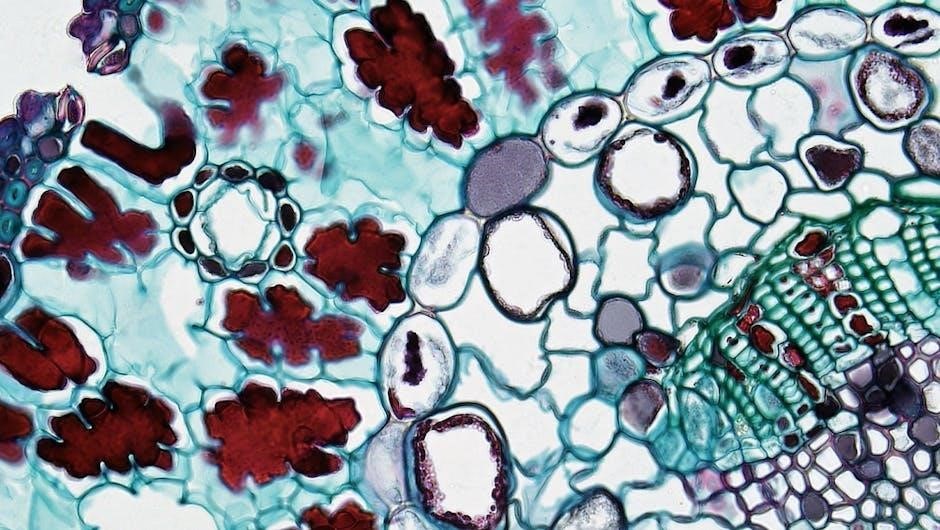Cell worksheets are essential educational tools for biology students, offering structured exercises to explore cellular structures and functions. Available in PDF formats, they provide interactive learning experiences, making complex concepts engaging and accessible. These resources often include labeled diagrams, review questions, and practical activities, fostering a deeper understanding of cell biology. They are widely used in classrooms and self-study settings to reinforce theoretical knowledge through hands-on tasks.
1.1 What are Cell Worksheets?
Cell worksheets are educational resources designed to help students explore and understand cell biology concepts. Typically available as PDF documents, they provide structured exercises, diagrams, and questions to engage learners. These tools cover topics like cell structure, functions, and processes, offering interactive activities to reinforce theoretical knowledge. They often include labeled diagrams of cell organelles, multiple-choice questions, and fill-in-the-blank exercises. Worksheets may also feature case studies or practical scenarios to apply knowledge. They are suitable for various learning levels, making them versatile for both classroom and self-study environments. By using cell worksheets, students can gain a deeper understanding of cellular biology in an engaging and effective manner.
1.2 Importance of Cell Worksheets in Biology Education
Cell worksheets are vital educational tools that enhance students’ understanding of biology concepts. They provide structured exercises and activities that make learning interactive and engaging. By focusing on specific topics like cell structure and function, worksheets help students grasp complex biological processes. They also improve retention by reinforcing key concepts through repetition and practical application. Additionally, cell worksheets cater to different learning styles, offering visual and hands-on experiences. They are particularly useful for assessing students’ knowledge and identifying areas that require further study. Overall, cell worksheets play a crucial role in making biology education accessible, effective, and enjoyable for learners of all levels;

Structure of a Cell
A cell’s structure includes a cell wall, membrane, and cytoplasm, with organelles like the nucleus, mitochondria, and chloroplasts performing specialized functions. Worksheets help visualize these components effectively.
2.1 Cell Wall and Membrane
The cell wall and membrane are critical structural components. The cell wall provides support, protection, and maintains the cell’s shape, while the membrane regulates the movement of substances. In plant cells, the wall is rigid due to cellulose, whereas animal cells lack a wall. The membrane, composed of lipids and proteins, is semi-permeable, allowing selective transport. Worksheets often include diagrams and labels to help students distinguish these structures. Activities may involve identifying the membrane’s role in osmosis or comparing wall compositions across organisms. These exercises enhance understanding of cellular integrity and function, making complex concepts accessible through visual and interactive learning tools.
2.2 Cytoplasm and Its Components
Cytoplasm, the jelly-like substance within cells, consists of water, salts, sugars, and organelles. It serves as a medium for chemical reactions and transports nutrients and waste. Worksheets often include activities to label and identify cytoplasmic components, such as ribosomes, lysosomes, and the cytoskeleton. These exercises help students understand the dynamic nature of cytoplasm and its role in cellular processes. Interactive diagrams and fill-in-the-blank questions are common, making learning engaging. By studying cytoplasm, students gain insights into how cells maintain homeostasis and carry out essential functions, reinforcing their grasp of cellular biology through practical tasks and visual aids.

Functions of Cells
Cells perform essential functions like metabolism, reproduction, and responding to stimuli. Worksheets often include activities that explore these processes, helping students understand cellular roles in organisms. Interactive and engaging.
3.1 Basic Cellular Functions
Basic cellular functions are fundamental processes that sustain life. These include metabolism, reproduction, and maintaining homeostasis. Worksheets often feature exercises that detail how cells perform these tasks, such as photosynthesis in plant cells and respiration in animal cells. By analyzing these processes, students gain insight into the universal roles of cells in different organisms. Activities in these resources also emphasize the importance of cellular transport mechanisms, like diffusion and osmosis, which are vital for nutrient uptake and waste removal. Such topics are essential for understanding how cells operate as the building blocks of life, ensuring survival and functionality in various biological systems.
3.2 Specialized Functions in Different Cells
Specialized cells perform unique roles tailored to their specific functions within organisms. For instance, nerve cells transmit signals, while muscle cells contract to enable movement. Plant cells like palisade cells specialize in photosynthesis due to their high chloroplast content. Worksheets often highlight these differences, providing diagrams and case studies to illustrate how specialized cells contribute to overall organismal function. By analyzing these examples, students learn how cellular diversity underpins biological complexity. Such exercises are crucial for understanding adaptation and the interconnectedness of life processes, making cell biology more engaging and accessible through structured learning materials.

Plant vs. Animal Cells
Plant cells have cell walls, chloroplasts, and large vacuoles, enabling functions like photosynthesis and rigid support. Animal cells lack these features but are more flexible and mobile.
4.1 Structural Differences
Plant cells are distinct due to their rigid cell walls, chloroplasts for photosynthesis, and large vacuoles for storage. These features are absent in animal cells. Animal cells lack cell walls but have centrioles for cell division. Plant cells also contain plasmodesmata for intercellular communication, whereas animal cells rely on gap junctions. Additionally, plant cells often have a larger nucleus-to-cytoplasm ratio. These structural differences are critical for their specialized functions, such as photosynthesis in plants and mobility in animals. Worksheets and PDF resources highlight these variations, aiding students in understanding and comparing cell types effectively through diagrams and labeled illustrations.
4.2 Functional Differences
Plant and animal cells exhibit distinct functional differences due to their specialized roles. Plant cells primarily perform photosynthesis, utilizing chloroplasts to convert light energy into chemical energy. This process is absent in animal cells. Animal cells, however, are more mobile and capable of rapid responses due to their flexible cell membranes. Additionally, plant cells manage storage and support functions through vacuoles and cell walls, while animal cells focus on movement and reproduction. Worksheets and PDF guides often include activities that explore these functional contrasts, helping students understand how cellular structures align with their roles in different organisms through interactive exercises and visual aids.

Cell Organelles
Cell organelles are specialized structures within cells, each performing unique functions. Worksheets often include diagrams and activities to study organelles like the nucleus, mitochondria, and chloroplasts, enhancing learning through visual aids and interactive exercises.
5.1 Nucleus and Its Role
The nucleus is the control center of eukaryotic cells, storing genetic material and regulating cellular activities. It contains DNA, which holds genetic instructions, and is surrounded by a double membrane called the nuclear envelope. The nucleus plays a crucial role in cell growth, metabolism, and reproduction by controlling gene expression. Worksheets often include diagrams of the nucleus, highlighting its components like chromatin, nucleoli, and nuclear pores. Activities such as labeling diagrams or matching terms help students understand its functions. The nucleus is essential for processes like transcription, where DNA is transcribed into RNA, and replication, ensuring genetic continuity. Educational resources, including PDF worksheets, emphasize its importance in cell biology.
5.2 Mitochondria: The Powerhouse
Mitochondria are often called the “powerhouses” of cells due to their role in producing energy through ATP synthesis. These organelles have a double membrane structure, with cristae increasing surface area for efficient energy production. Worksheets often include diagrams of mitochondria, allowing students to label and explore their components. Activities focus on understanding the process of cellular respiration, where mitochondria convert glucose into ATP. Educational resources, such as PDF worksheets, help students grasp the critical function of mitochondria in sustaining life and powering cellular activities. Interactive exercises make learning about energy production engaging and accessible for biology students of all levels.
5.3 Endoplasmic Reticulum and Golgi Apparatus
The endoplasmic reticulum (ER) and Golgi apparatus are key organelles in protein synthesis and transport. The ER, with its rough and smooth surfaces, processes proteins and lipids, while the Golgi apparatus modifies and distributes them. Worksheets often include diagrams for labeling these structures and their functions. Activities such as matching games and fill-in-the-blanks help students understand the “factory” system of the cell. Resources like PDF worksheets provide interactive learning tools, ensuring a comprehensive grasp of these organelles’ roles in cellular operations. Such educational materials are invaluable for reinforcing concepts in cell biology, making complex processes easier to understand through visual and practical exercises.
Processes in Cells
Cell worksheets explore essential processes like photosynthesis, respiration, and transport mechanisms. These activities help students understand how cells function, making complex biological processes engaging and accessible through interactive exercises.
6.1 Photosynthesis in Plant Cells
Photosynthesis is a vital process in plant cells, converting sunlight into energy through chlorophyll in chloroplasts. Worksheets often include diagrams of chloroplast structures and equations for the process. Activities may involve labeling parts of the chloroplast, such as the thylakoid membranes and stroma, and understanding the light-dependent and light-independent reactions. Students learn how palisade cells, located near the leaf surface, maximize light absorption for efficient photosynthesis. These educational tools also explore the role of stomata in gas exchange and the importance of ATP and NADPH in energy transfer. By engaging with these materials, learners gain a comprehensive understanding of how plants sustain life through photosynthesis.
6.2 Respiration in Animal Cells
Respiration in animal cells is a critical process that converts glucose into energy (ATP), enabling cellular functions. Worksheets often detail the stages: glycolysis, the citric acid cycle, and oxidative phosphorylation. Glycolysis occurs in the cytoplasm, while the citric acid cycle and electron transport chain take place in mitochondria. These resources highlight the importance of oxygen in aerobic respiration and the production of carbon dioxide as a byproduct. Interactive activities, such as labeling mitochondrial structures or calculating ATP yield, reinforce understanding. By engaging with these materials, students grasp how cells efficiently generate energy, supporting life-sustaining processes in animals.
6.3 Transport Mechanisms
Transport mechanisms are vital for cells to exchange materials with their environment, ensuring survival and proper function. Worksheets often focus on passive transport (diffusion, osmosis) and active transport, explaining how cells move substances across membranes. Passive transport relies on concentration gradients, while active transport requires energy (ATP). These resources also cover endocytosis and exocytosis, highlighting their roles in bulk transport. Interactive diagrams and questions help students visualize how cells maintain homeostasis and acquire essential nutrients. By studying these mechanisms, learners gain insights into how cells interact with their surroundings and sustain life processes, making transport mechanisms a cornerstone of cellular biology education.

Cell Cycle and Division
Cell cycle and division worksheets simplify understanding of mitosis and meiosis, offering diagrams and exercises. They guide students through phases like interphase, metaphase, and cytokinesis, ensuring comprehensive learning.
7.1 Phases of the Cell Cycle
The cell cycle consists of four main phases: G1, S, G2, and M. G1 is the gap phase where the cell grows and prepares for DNA replication. In the S phase, DNA replication occurs, ensuring genetic material is duplicated; The G2 phase allows the cell to finalize preparations for cell division. The M phase includes mitosis and cytokinesis, where the cell divides into two identical daughter cells. Worksheets on the cell cycle often include diagrams and exercises to help students identify and understand these phases. They also provide activities to calculate the duration of each phase under a microscope, enhancing practical learning.
7.2 Mitosis vs. Meiosis
Mitosis and meiosis are two types of cell division with distinct purposes. Mitosis results in two genetically identical diploid cells and is essential for growth, tissue repair, and asexual reproduction. It consists of four stages: prophase, metaphase, anaphase, and telophase. Meiosis, however, produces four genetically unique haploid cells (gametes) through two consecutive divisions, introducing genetic diversity. Worksheets often compare these processes, highlighting differences like the number of daughter cells and genetic variation. Diagrams in PDF resources illustrate these processes, helping students grasp how mitosis maintains organismal stability, while meiosis drives biodiversity. These exercises are crucial for understanding cellular reproduction and genetic principles in biology education.

Practical Activities
Practical activities, such as microscopy and lab experiments, enhance students’ understanding of cell biology. Worksheets guide observations, fostering hands-on learning and critical thinking about cellular structures and functions.
8.1 Microscopy and Cell Observation
Microscopy is a fundamental practical activity in cell biology, allowing students to observe cellular structures firsthand. Worksheets often include exercises for identifying cell components under a microscope. For example, observing onion epidermal cells helps students understand cell walls and nuclei. Similarly, studying palisade cells reveals chloroplasts and their role in photosynthesis. These activities are guided by worksheets that provide structured questions and diagrams, enhancing learning. Microscopy sessions encourage critical thinking and reinforce theoretical concepts, making abstract ideas tangible. Worksheets also include review questions to assess understanding, ensuring students grasp the significance of cell structures in biological processes.
8.2 Lab Experiments for Cell Study
Lab experiments deepen students’ understanding of cell biology by allowing hands-on exploration. Common activities include observing osmosis in potato cells, demonstrating transport mechanisms, and isolating cell components. Worksheets guide students through procedures, such as preparing slides or recording data. For example, examining starch digestion in leaves highlights enzyme activity. Practical tasks like culturing cells or staining tissues provide insights into cellular structures. These experiments are often paired with worksheet questions to reinforce learning. Advanced labs may involve analyzing cell cycle phases or exploring photosynthesis rates. Such activities enhance critical thinking and skill development, making abstract concepts tangible and engaging for learners at all levels.

Importance in Education
Cell worksheets are vital educational tools, enhancing interactive learning and reinforcing key biological concepts. They serve as effective assessment resources, ensuring comprehensive understanding and practical application of cell biology principles.
9.1 Enhancing Learning Through Worksheets
Cell worksheets significantly enhance learning by providing structured, interactive exercises that cater to diverse learning styles. They incorporate visual aids, diagrams, and practical tasks, making complex biological concepts engaging. These resources encourage active learning, allowing students to explore cell structures and functions through hands-on activities. Worksheets often include labeled diagrams for identification, review questions for assessment, and case studies for deeper understanding. By focusing on specific topics like organelles or processes, they help students build a comprehensive knowledge base. Additionally, worksheets facilitate self-assessment, enabling learners to track their progress and identify areas for improvement, thereby reinforcing their grasp of cell biology effectively.
9.2 Assessment Tools in Biology
Cell worksheets serve as valuable assessment tools in biology education, enabling teachers to evaluate students’ understanding of cellular concepts. They often include multiple-choice questions, fill-in-the-blanks, and diagram labeling exercises, providing a comprehensive way to test knowledge. These worksheets cover topics such as cell structure, functions, and processes, allowing for targeted assessments. By incorporating exercises like identifying organelles or explaining photosynthesis, they help teachers gauge mastery of key concepts. Additionally, worksheets facilitate formative and summative assessments, enabling educators to track student progress and identify areas needing further instruction. They are versatile tools that support both learning and evaluation in biology classrooms effectively.

Creating Effective Worksheets
Effective worksheets integrate visual aids and clear instructions, enhancing learning outcomes. They are designed using platforms like Excel, ensuring structured activities for practical exercises and assessment tools.
10.1 Designing for Different Learning Levels
Creating effective worksheets involves tailoring content to suit various learning levels. Basic worksheets may include fill-in-the-blank exercises, while advanced versions incorporate complex problem-solving. Visual aids, like diagrams, enhance understanding for visual learners. Teachers can use tools like Excel to design customizable templates, ensuring accessibility for diverse student needs. Interactive elements, such as labeled cell diagrams, cater to different learning styles. This approach ensures that students grasp key concepts, from basic cell structure to advanced cellular functions, fostering a deeper engagement with biology. By adapting worksheets to learning levels, educators can address individual needs, promoting a more inclusive and effective learning environment for all students.
10.2 Including Visual Aids and Diagrams
Incorporating visual aids and diagrams into cell worksheets enhances learning by making complex concepts more accessible. Diagrams of cell structures, such as the nucleus and mitochondria, help students visualize and understand their functions. Labeled illustrations of processes like photosynthesis or mitosis provide clear, interactive learning tools. Worksheets with micrographs of cells, obtained through microscopy, allow students to observe real-world examples. Including activities like labeling diagrams or matching organelles to their roles engages students and reinforces retention. These visual elements cater to different learning styles, ensuring that all students can grasp key concepts effectively. They also make worksheets more engaging and interactive, fostering a deeper interest in cell biology.

Advanced Topics
Advanced topics in cell biology include stem cell potential, cancer cell behavior, and cell cycle regulation. These concepts explore cutting-edge research and applications in modern biology, enhancing deeper understanding.
11.1 Stem Cells and Their Potential
Stem cells are undifferentiated cells with the unique ability to develop into various specialized cell types, making them crucial for tissue repair and regeneration. Their potential in regenerative medicine is vast, offering promising treatments for diseases like Parkinson’s and diabetes. Researchers use computational tools, such as Microsoft Excel and STATISTICA, to analyze stem cell behavior and optimize protocols for 3D cell structures. These advancements highlight the significance of stem cell biology in modern medical research and its application in developing innovative therapies. Understanding stem cells through worksheets and lab experiments provides students with hands-on insights into their biological importance and future applications in healthcare.
11.2 Cancer Cells and Their Behavior
Cancer cells exhibit unique behaviors, including uncontrolled growth, evasion of immune detection, and metastasis to distant tissues. These cells often display genetic instability, leading to continuous mutations and adaptation. Research focuses on identifying biomarkers to understand immune cell populations driving chronic inflammation and cancer progression. For instance, transcriptomic analysis of samples helps uncover molecular mechanisms behind cancer cell behavior. Educational resources like cell worksheet PDFs provide interactive exercises for students to explore these concepts. Activities include labeling diagrams of cancer cells, analyzing their structure, and understanding their role in diseases like uveal melanoma. Such worksheets enhance learning by connecting theoretical knowledge with practical observation and analysis;
Cell worksheets are invaluable educational tools, enhancing learning through structured exercises and practical activities. They simplify complex biological concepts, making them accessible for students. Future studies will further integrate advanced topics like stem cells and cancer biology, ensuring a comprehensive understanding of cellular processes and their real-world applications.
12.1 Summary of Key Concepts
Cell worksheets are essential tools for biology education, providing structured exercises to explore cellular structures, functions, and processes. Key concepts include cell membranes, organelles like mitochondria and chloroplasts, and transport mechanisms. Plant and animal cells differ in structures such as cell walls and chloroplasts. Photosynthesis and respiration are critical cellular processes. Cell division, including mitosis and meiosis, is fundamental for growth and reproduction. Practical activities, like microscopy and lab experiments, enhance understanding. Worksheets simplify complex topics, making learning interactive and accessible. They are invaluable for reinforcing theoretical knowledge and developing practical skills, ensuring a comprehensive grasp of cell biology for students at all levels.
12.2 Future of Cell Biology Studies
The future of cell biology studies lies in integrating advanced technologies and innovative educational tools. Emerging techniques like single-cell analysis and real-time imaging will deepen our understanding of cellular mechanisms. Computational tools, such as AI-driven simulations, will enhance worksheet-based learning. Stem cell research and cancer biology will remain focal points, offering insights into regenerative medicine and disease treatment. Interactive and personalized learning resources, including dynamic PDF worksheets, will cater to diverse learning needs. Collaborative activities and virtual labs will further enrich student engagement; As cell biology evolves, worksheets will adapt, ensuring they remain vital resources for both foundational and advanced studies in this ever-expanding field.
